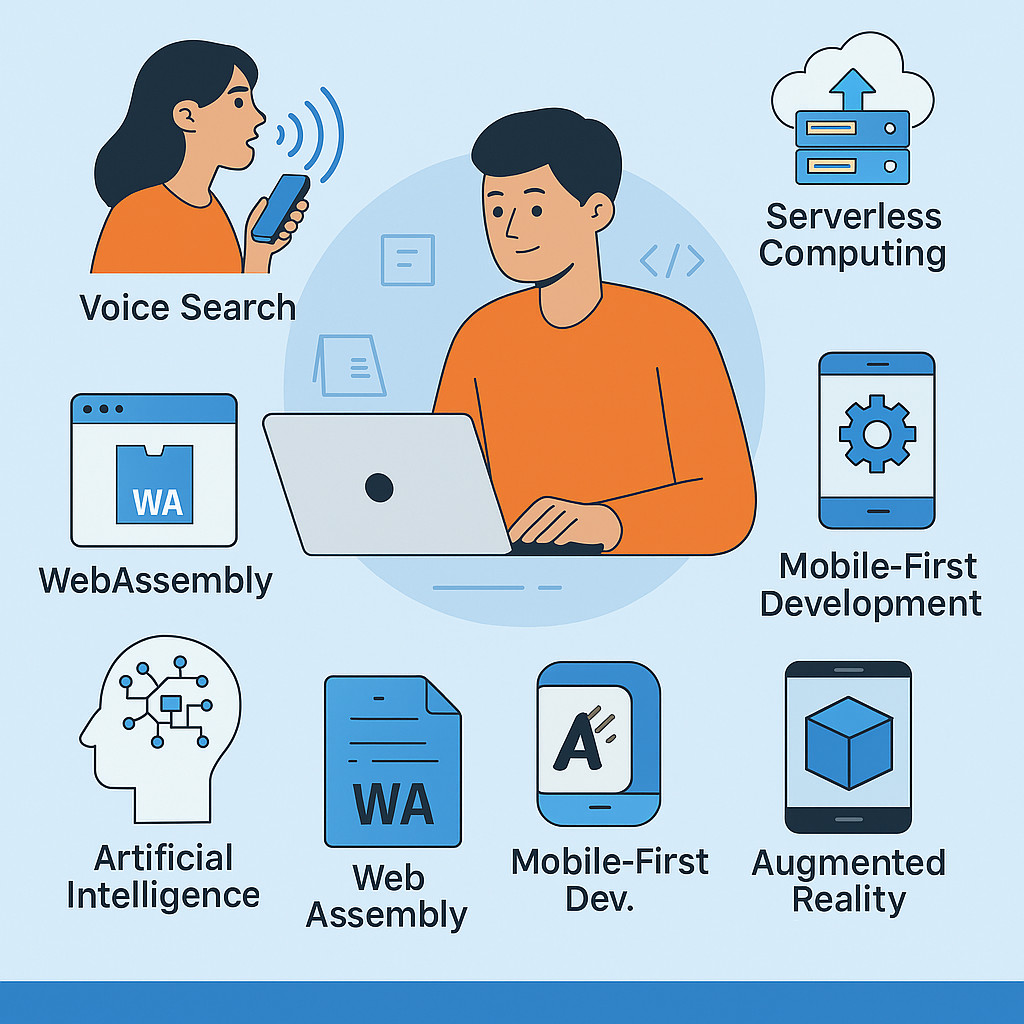Web Development Trends for 2025: What Beginners Should Know About the Future
Introduction: A New Digital Era Post-Pandemic
The global pandemic not only reshaped the way we live and work—it accelerated digital transformation at an unprecedented scale. In the world of web development, this shift has created new demands and opportunities. Businesses are now more focused on creating fast, user-friendly, and engaging digital experiences.
With Google’s Page Experience update and users expecting more personalized, voice-powered, and mobile-first experiences, the future of web development is being shaped by rapid innovation.
If you’re a beginner or aspiring web developer, understanding the upcoming trends can give you a head start. Here are the top web development trends for 2025 and beyond.
Web Development Trends
1. Voice Search Optimization
Voice assistants like Siri, Alexa, and Google Assistant are changing how people interact with websites. Instead of typing queries, more users are speaking them.
Why it matters:
- Faster and hands-free search
- Better accessibility for visually impaired users
- Improves SEO with conversational content
As a developer, optimizing for voice search means using natural language keywords, integrating speech recognition APIs, and designing with accessibility in mind.
2. Serverless Architecture
Serverless computing allows developers to build applications without worrying about the underlying infrastructure. Services like AWS Lambda, Microsoft Azure Functions, and Google Cloud Functions handle server management automatically.
Benefits:
- Reduced infrastructure cost
- Automatic scaling
- Faster deployment
It’s a great starting point for beginners who want to focus more on code than on server maintenance.
3. Cybersecurity and Data Privacy
As websites and apps handle more personal data, security becomes essential. Data breaches can lead to loss of trust, legal trouble, and financial damage.
Key Practices:
- Use HTTPS for all websites
- Implement secure authentication (e.g., 2FA)
- Encrypt sensitive user data
- Regularly update and test your web apps for vulnerabilities
For beginners, learning basic web security principles is a must-have skill.
4. WebAssembly (Wasm)
WebAssembly allows developers to run high-performance code (like C, C++, or Rust) directly in the browser alongside JavaScript. It helps speed up complex applications, especially games, video editors, and simulations.
Why it’s trending:
- Improved speed and performance
- Language flexibility (not limited to JavaScript)
- Enables desktop-level apps in the browser
5. Mobile-First Design and Indexing
More than half of all web traffic comes from mobile devices. Google now indexes mobile versions of sites before desktop versions. This means your mobile experience matters more than ever.
What beginners should focus on:
- Responsive layouts using CSS Grid and Flexbox
- Fast loading times
- Touch-friendly navigation
6. Artificial Intelligence and Chatbots
AI-powered chatbots are becoming standard for customer service, support, and user engagement. They can answer questions, guide users, and even collect feedback.
Tools to explore:
- Dialogflow (Google)
- Microsoft Bot Framework
- IBM Watson
AI also powers personalized content and smart recommendations based on user behavior.
7. Machine Learning in Web Development
Machine Learning (ML) lets web apps learn from data to make better decisions. This can improve search results, suggest products, or detect spam.
Examples in action:
- Netflix recommends shows
- Amazon suggests products
- Gmail filters spam
Beginners can explore ML APIs like TensorFlow.js and Python backends to get started.
8. Progressive Web Apps (PWAs)
PWAs combine the best of web and mobile apps. They load fast, work offline, and can be installed on devices like native apps.
Key benefits:
- Works offline using service workers
- No need to install from app stores
- Faster and more reliable user experience
PWAs are beginner-friendly and a great way to build your first powerful web app.
9. Augmented Reality (AR) Integration
AR adds digital elements to the real world through the browser. It’s being used in ecommerce, education, and virtual tours.
Why it’s exciting:
- Try-on features in fashion and makeup
- Virtual furniture placement for home shopping
- Enhanced learning experiences
Tools like A-Frame and AR.js let beginners experiment with AR on the web.
10. The Curiosity of Web Developers
Technology moves fast, and the best developers stay curious. Whether it’s learning a new framework or exploring new tools, being open to growth is essential.
Tips for beginners:
- Follow blogs like Smashing Magazine or CSS-Tricks
- Join online communities (Reddit, Stack Overflow, GitHub)
- Take online courses (FreeCodeCamp, Coursera, Udemy)
Wrapping Up: Embrace the Future of Web Development
These web development trends for 2025 will help shape how we build and use websites in the near future. Whether you’re a beginner learning HTML or a junior developer working with frameworks like React or Vue, staying informed about these trends is a smart move.
Start exploring, experimenting, and building. With advancements in AI, immersive technologies, and mobile-first experiences, the web is evolving faster than ever—and there’s never been a better time to be part of it. will help shape how we build and use websites in the near future. Whether you’re a beginner learning HTML or a junior developer working with React, staying informed about these trends is a smart move.
Start exploring, experimenting, and building. The web is evolving—and there’s never been a better time to be part of it.
See also: What is an API ? Making Things Easier for Developers
For more beginner-friendly tutorials, check out our IoT Basics section, or subscribe to our YouTube channel for hands-on videos.
Let us know your thoughts on 2025’s web development trends in the comments below!










Leave a Review